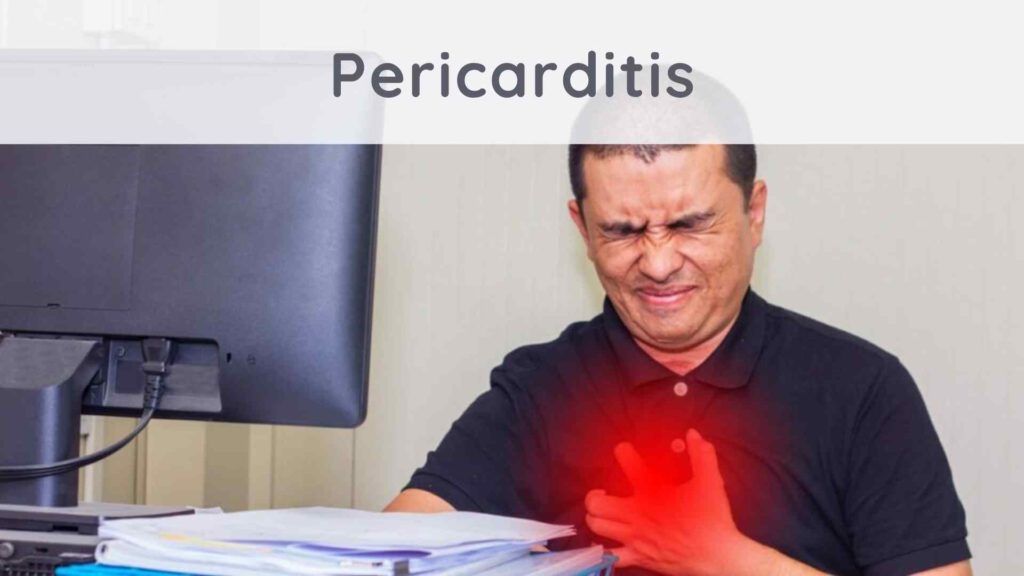Pericarditis : how to release the pericardium ?
Written by: Loris Vitry (holistic coach)
Validated by: Cathy Maillot (Osteopath)
Caution: If you have any medical questions or concerns, please speak to your doctor. Even if the articles on this site are based on scientific studies, they do not replace professional medical advice, diagnosis or treatment.

The heart is the sensitive and essential organ of the organism because of its role in regulating blood circulation throughout the body.
The pericardium envelops it: a fibro-serous layer made up of two very resistant membranes.
It protects the heart from infections, physical and emotional shocks.
Among the dysfunctions that can cause a malfunction of the pericardium is Pericarditis.
This article looks at how to release the pericardium in the case of Pericarditis.
Detailed overview of pericarditis
Pericarditis is an inflammation of the pericardium that causes pain, irritation, and swelling.
It can be due to several reasons, one distinguishes among others:
- An infection: viral, bacterial or fungal
- A heart attack
- Kidney failure
- Rheumatic fever (rheumatic)
- Scleroderma
- Systemic or systemic lupus erythematosus
- A tumor
- Rheumatoid arthritis
- Heart surgery
The most frequent manifestation of Pericarditis is the acute pain felt in the chest precisely in the thorax.
This pain is usually on the left side of the chest, but in some cases to the neck also.
It is amplified in the event of movements of position changes and is described as throbbing, tearing, sharp, oppressive.
Also, other symptoms are remarkable in the case of Pericarditis.
These include breathing difficulties, heart palpitations, abdominal swelling, coughing, etc.
It is advisable to seek medical advice if any of these symptoms persist.
The health professional can make an accurate diagnosis and administer appropriate treatment.
Diagnosis of pericarditis
The medical diagnosis is made based on the patient’s medical history, analysis of the symptoms experienced, and a full medical examination.
The full medical examination involves various in-depth analyzes that give a more accurate picture of the patient’s health based on several parameters.
In-depth analyzes include; blood tests, cardiac catheterization, echocardiogram, chest X-ray, magnetic resonance imaging of the heart, cardiac computed tomography.
This diagnosis can lead to the detection of several forms of Pericarditis.
We distinguish :
Acute pericarditis
It manifests itself by diffusion of the liquid between the two membranes of the pericardium.
We talk about pericardial effusion.
This form of Pericarditis is generally mild and can be cured without medical or medical assistance within a few days or weeks.
There are also cases of complication of Pericarditis with imprisonment of the heart in the inflammation making its contraction difficult.
It is :
Chronic pericarditis
It lasts on average for more than three months and is usually caused by a prolonged infection such as tuberculosis.
It results in the formation of an envelope that traps the heart and prevents it from beating.
It is the rarest form of Pericarditis that requires cardiac surgery to free the heart from the envelope.
Post-infarction pericarditis
Also known as Dressler Syndrome, it is a late form of Pericarditis that is usually caused by an immune system reaction to an injury.
It can also be due to a previous heart attack, heart intervention, or any other traumatic heart injury.
Pericarditis can also occur when the pericardium is wrapped in a substance called fibrin.
Also, when it has a calcified or fibrous thickening, we speak of constrictive Pericarditis.
Treatment of pericarditis and release of the pericardium
After the diagnosis made by the doctor comes the stage of prescribing treatment to treat the condition.
This treatment is mainly aimed at calming the pain felt by reducing the inflammation of the pericardium.
We also work to identify and treat the causes of the disorder to avoid possible complications.
Indeed, the treatment of Pericarditis varies greatly depending on the cause and the nature of the pathology.
When the disease is infectious, antibiotics are usually prescribed.
On the other hand, when it is viral, aspirin and complete rest are enough to speed up the healing process.
In the recovery process, after an episode of Pericarditis, it is important to respect components of a healthy life, these include, among others:
- Exercise regularly to keep fit
- Balanced and healthy diet
- Stop smoking
- Reduce alcohol consumption
- Keep distance from stress and anxiety situations.
The pericardium has neurophysiological and anatomical insertions that link it intimately to the entire body.
Thus, any reaction of the pericardium automatically causes the affection of the organism in its entirety.
This central place occupied by the pericardium in the body makes it essential to release when it is tensed.
Releasing the pericardium consists of relaxing any tension, using small exercises and movements.
The primary mechanism for releasing the pericardium is deep breathing.
It effectively oxygenates the cells, which in turn transmit them to tissues, organs, and membranes such as the pericardium.
This inhalation and exhalation action massages the pericardium allowing it to relax and release itself.
There is a method of release called Cellular Bioenergetic Osteopathy and Release of the Pericardium.
It was developed by Montserrat Gascon.
These are the results of more than 30 years of research on the subject.
It is a healing technique based on the awakening by the hands of the practitioner of energy and cellular dialogue.
It is applied at first by a methodical and very soft touch of the energy points identified on the body, especially on the chest.
Then, we proceed to the establishment of a cellular dialogue to more easily ensure the deletion of the memories blocked and which are responsible for the persistent pain.
Already at this stage, we can see an invigoration of the organs.
From then on, the automatic healing capacities of these organs resume their normal functioning.
This technique, with the help of restoring the energy flow, aims to release the pericardium by balancing the body, soul, and spiritual dimensions.
Indeed, the body is harmonized, the self-healing forces are mobilized, which frees life from all oppression (allusion made to the oppressed pericardium).
Keep in mind that suffering from Pericarditis is not inevitable.
A well-developed diagnosis and adequate treatment will free the pericardium.
Continue reading:
Caffeine addiction : how to stop coffee ?

